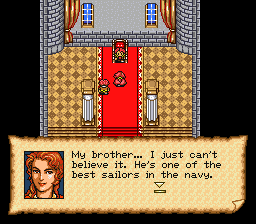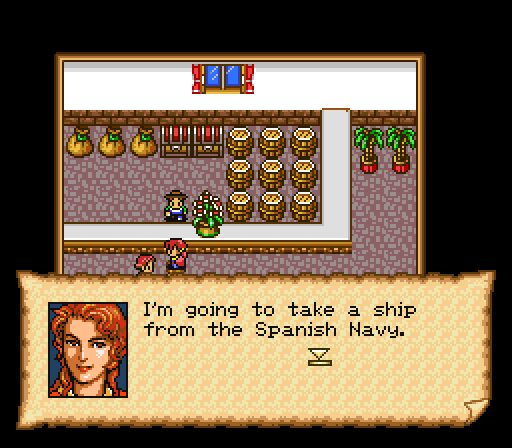
Note: This website contains almost no TokiMemo content.
In fact, this picture is the only reference at this point.
New HorizonsPost 00034 | December 29th 2023 Growing up, I was positively mesmerised by games such Sid Meier's Pirates! or Tai Pan for the C64. There was something incredibly exciting about going back in time, getting on a boat and explore the world. Open world games are a dime a dozen these days, but back then, having a big world to navigate while having some vague objective to follow was very unique. I have always wondered why this kind of game concept wasn't more widespread back then, so you can imagine my surprise when about ten years ago, I found Uncharted Waters: New Horizons on the Wii U's Virtual Console. Released by Koei in 1993 as part of their "Rekoeition" series, New Horizons is the sequel to Uncharted Waters. The game takes you back to the 16th century where it lets you take to the sea with one of six different people, each with their own skills and objectives. You'll get to sail from city to city, living off exploration, trade or piracy. Go to the town's bar to hear the latest gossip and hire crewmen for your next expedition, sell your goods at the merchant so you can afford provisions for your crew. It's hard to deny the game has taken some obvious inspiration from Sid Meier's Pirates! but it also improves on the concept in many ways: While Pirates only saw you sailing around the Caribbean, in New Horizons, the entire world is your oyster. Cities are explorable as well, bringing some welcome RPG-elements to the table which is further complimented by six distinct playable characters from different countries. Cities vary from continent to continent, which does make exploring the world more interesting.   I played it briefly when it came out on the Virtual Console, but quit when a storm sank most of my fleet, so I figured I'd start a new game. As already stated, you have the option of picking one of six different people. I'll be playing as the girl; Catalina is Spanish pirate who has left the navy to look for her missing brother and fiancé.  I really admire the courage of this lass. Five minutes in and we have already committed treason by stealing one of the navy's ships. After the intro you're left to your own devices. You are advised to sell some gold that was left in the cargo of the ship you stole to get you started. You'll also get some pointers on how to attack other fleets, but other than that, you're free explore the game as you want. At least for Catalina, the story more or less stumbles upon you as you gain infamy as a pirate. Having dedicated free time in between the important bits was a very welcoming feeling. Often, modern open-world games have a sense of urgency to its story, making you feel guilty for playing the game rather than hurrying to the next objective.   As you sail the world, you may encounter villages. Unlike cities these aren't explorable, but if you search around in the area you may make new discoveries that can be sold to guilds or it can be used to woo barmaids who will then help you to gather intel. It should also be said that you aren't in any way forced to exclusively be a pirate. Nothing stops you from assembling a fleet, filling the cargo and sail to the other side of the earth, exploring on the way. In fact, I found attacking ships to be one of the more tedious aspects of the game. While blasting cannons sounds like it should be fun, the game goes into a slow, turn-based battle mode. You only control your flag ship and because the other side can have up to ten ships in its fleet, it's a waiting game rather than an action game. Thankfully, this is mostly skippable; If you have a big enough crew on your flagship, you are able to ram into the other side's flagship to initiate a sword-fighting duel (Sid Meier's Pirates, ahem). This is also turn-based and is more reminiscent of rock-paper-scissors. In true RPG fashion, you get an edge in these sword-fights by equipping better gear bought town item shops.   Got 'em! Every ship movement takes two to four seconds so with up to twenty ships, it may take up to a minute before its your turn again, making sword duels a lot faster. I had a lot more fun exploring the world. The map is based on the world, meaning its advantageous if you know your geography. Just bear in mind that it is the world map as it looked in the fourteen hundreds. I felt like a right idiot when I realised I had to sail all around Africa to get to the Middle East as the Suez Canal hadn't been dug yet.  As you play the game, the other playable characters make appearances which I think is a nice touch. Considering they are all on their own big quest, it would make sense that their paths would intertwine at some point or other. That said, some characters have greater roles than others. For about half of the characters, their entire screen time consisted of sailing by to point you in the right direction. This might seem unnecessary, it does mean that their stories aren't spoiled, should you want to start a new game as them.   A couple of examples of cities. It's a Chinese city on the left while the right is from Europe. People in the city may serve hints about the game or historical factoids. If there is one thing I should criticise, it would have to be the cities. While I love how the different regions have a distinct look, it doesn't take long to become stale. They might be laid out differently, but they are essentially the same city in a different skin. The habour master in Nagasaki and the one in Timbuktu will both greet will both greet you with a "matey". Some cultural differences would have helped to make the cities more interesting to explore. Instead, you get used to running through towns, only reading the signs to see if there are special places of interest, of if it is just another market town with a café, harbour, and inn. It doesn't feel alive, which is a real shame as it felt like that was what they were going for, making graphics for different places. Speaking of cultural differences, it would also appear that the American saw some changes when getting localised. I found it a bit strange that the scruffy  From the Japanese version of the game. Notice the cross and goblet signs. To summarise, I really enjoyed Uncharted Waters: New Horizons. It uses Sid Meier's Pirates! as a foundation and extends it with some RPG elements like a multiple playable characters each with their own story and cities to explore. I only played through Catalina's story so far, but seeing I liked the exploration aspect of it, I could see myself playing the game again as one of the explorers. It almost seems like a different game when you suddenly aren't able to rely on piracy for getting ships, money, and supplies. I would probably have to look more into the trading to survive. It's kind of wild how even though I beat the game, I only feel like I'm getting started with it. 
Uncharted Waters: New Horizons is available in English for the Mega Drive, Super Nintendo, DOS, Wii, and Wii U with the last two being emulated version of the Super Nintendo Version.
|